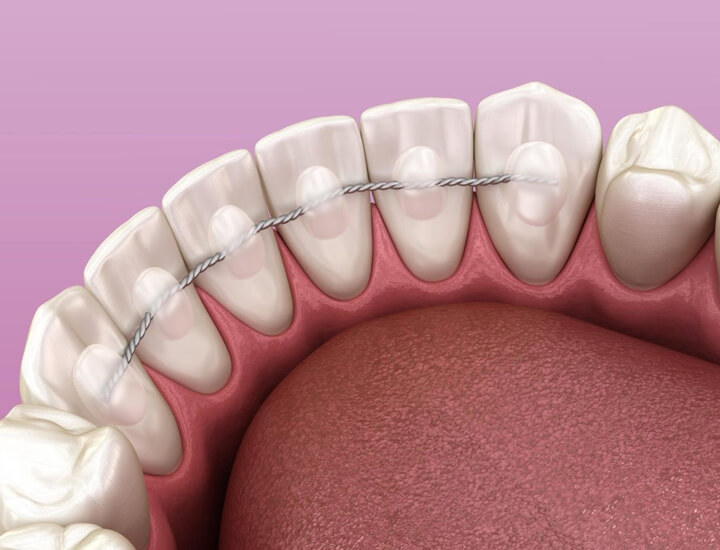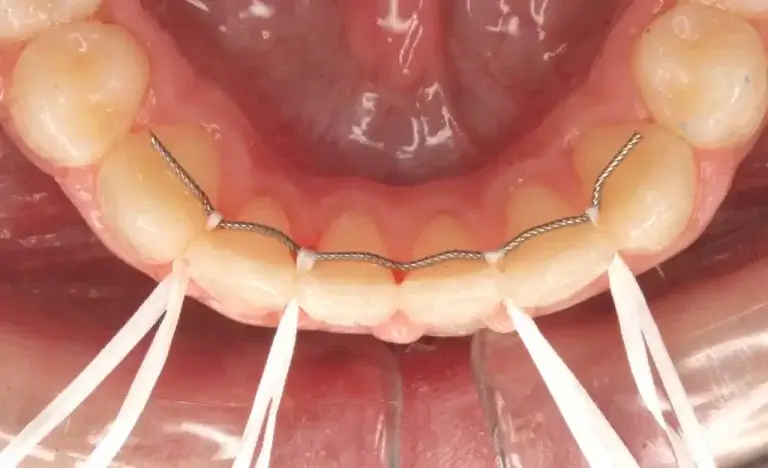Broken Permanent Retainer

What Is A Broken Permanent Retainer?
A permanent orthodontic retainer, also known as a lingual wire or fixed retainer, is a type of orthodontic appliance that is attached to the teeth to prevent them from shifting back to their original positions after braces are removed. It consists of a thin wire that is bonded to the back of the teeth and is designed to stay in place indefinitely. While permanent retainers are generally reliable, they can occasionally break in two pieces, come loose, or fall out entirely, which can cause discomfort, pain, and even dental problems.
- Why Do I Have A Broken Permanent Retainer?
- Signs And Symptoms Of A Broken Permanent Retainer
- Treatment Options For A Broken Permanent Retainer
- How To Prevent A Broken Permanent Retainer
- Managing A Broken Permanent Retainer Until You Can See The Dentist
If you have questions about A Broken Permanent Retainer or other dental problems, please contact us for more information.
Why Do I Have A Broken Permanent Retainer?
There are several reasons why a permanent lingual retainer may become loose, including:
- Biting down on hard foods: Parafunctional habits or chewing on hard or crunchy foods, like ice, hard candy, or nuts, can put extra pressure on your teeth and retainer, which may cause it to break over time.
- Trauma to the mouth: If you experience a blow to the mouth, such as from a sports injury or accident, it can cause your retainer to become dislodged or loose.
- Normal wear and tear: Over time, the cement that holds your retainer in place may wear down, which can cause it to break or even fall off.
- Poor oral hygiene: Neglecting your oral hygiene can lead to the buildup of plaque and tartar around your retainer, which can weaken the bond between the retainer and your teeth. Poor oral hygiene can also cause gum disease and tooth decay.
It’s important to address a broken permanent retainer as soon as possible, as it can lead to further dental problems if left untreated. If you have further questions about A Broken Permanent Retainer, please contact us.
Signs And Symptoms Of A Broken Permanent Retainer
It’s important to be aware of the signs and symptoms of a broken lingual wire, which can include:
- Feeling a shift in your teeth: If your retainer becomes broken, you may feel your teeth shifting out of place, which can be very disappointing if you have spent lots of effort trying to straighten your teeth.
- A change in your bite: As your teeth shift, you may notice a change in the way your upper and lower teeth fit together when you bite down. Changes in the bite can cause premature wearing away of teeth and tooth sensitivity.
- Discomfort or pain: A broken permanent retainer can cause discomfort or even pain, especially if the sharp end of the retainer is cutting into your tongue or gum.
- Visible movement of the wire: You may be able to see that the wire is no longer flush against your teeth, has shifted out of place, and can move freely around.
If you experience any of these symptoms, it’s important to schedule an appointment with your dentist or orthodontist to have your retainer checked and repaired as necessary. If you have further questions about signs and symptoms of A Broken Permanent Retainer, please contact us.
Treatment Options For A Broken Permanent Retainer
If you have a broken permanent retainer, there are several treatment options available, including:
- Rebonding the retainer: If the retainer is still intact on most teeth and the dental bonding that holds it in place is still serviceable, your dentist or orthodontist may be able to simply rebond it in place.
- Replacing the retainer with a new retainer wire: If the retainer is damaged or worn down, or all the dental bonding that holds the wire in place is getting old and needs replacement, it may need to be replaced with a new retainer wire with fresh dental bonding.
- Replacing the retainer with a removable retainer: An alternative solution to a fixed retainer wire is a removable retainer. Not only do removable retainers not have the same debonding issues as permanent retainers, they allow for easier dental hygiene and can be worn comfortably for night time wear only.
- Removing the retainer altogether: If it is a recurring problem where the retainer wire keeps coming broken and falling out time and time again, your dentist can remove the retainer altogether.
- Cutting the retainer short: If a broken end of the permanent retainer is rubbing against your cheeks or gums, your dentist or orthodontist may be able to cut it shorter to make it more comfortable.
It is important to have a broken permanent retainer addressed as soon as possible to avoid further dental problems. Your dentist or orthodontist can recommend the best course of treatment for your specific situation. If you have further questions about treatment options for A Broken Permanent Retainer, please contact us.

How To Prevent A Broken Permanent Retainer
While some causes of a broken permanent lingual wire are beyond your control, there are steps you can take to help prevent it from happening, including:
- Avoiding hard or crunchy foods: Chewing on hard or crunchy foods can put extra pressure on your teeth and retainer, which may cause it to break over time.
- Wearing a mouthguard during sports: If you participate in sports or other high-impact activities, wearing a mouthguard can help protect your teeth and retainer from dental trauma.
- Practicing good oral hygiene: Brushing and flossing regularly can help prevent the buildup of plaque and tartar around your retainer, which can weaken the bond between the retainer and your teeth. Brush and floss gently around the permanent retainer. The Waterpik waterflosser is also a terrific adjunctive tool to keep the area around the retainer wire clean.
- Visiting your dentist regularly: Regular dental checkups and teeth cleanings can help ensure that your retainer is in good condition and catch any issues before they become more serious.
By taking these steps, you can help reduce your risk of breaking a permanent retainer and ensure that your orthodontic treatment is effective for the long term. If you have further questions about how to prevent A Broken Permanent Retainer, please contact us.
Managing A Broken Permanent Retainer Until You Can See The Dentist
If you experience a broken permanent retainer and are unable to see your dentist or orthodontist immediately, there are a few steps you can take to manage the issue until you can schedule an appointment, including:
- Avoiding hard or sticky foods: Stick to soft foods that won’t put extra pressure on your teeth and retainer, and avoid anything sticky that could dislodge the retainer further.
- Using orthodontic wax: If the retainer is rubbing against your cheeks or gums, you can use orthodontic wax to cover the wire and make it more comfortable.
- Wear a removable retainer: If you have a spare removable orthodontic retainer, you may consider wearing it to prevent further tooth movement until you can get the permanent retainer replaced.
- Use Over-the-Counter Pain Medication: Over-the-counter pain medication, such as acetaminophen or ibuprofen, can help relieve tooth pain or sensitivity from a broken permanent retainer. Follow the instructions on the label and do not exceed the recommended dose. Unless you have a health condition that prevents you from taking either ibuprofen or acetaminophen, the absolute maximum dose that I recommend patients take for the worst dental pain is 600 mg ibuprofen combined with 1000 mg acetaminophen every 4 to 6 hours.
It’s important to remember that these are temporary solutions and that you should still see your dentist or orthodontist as soon as possible to have the issue addressed properly. If you have further questions about how to manage A Broken Permanent Retainer, please contact us.

